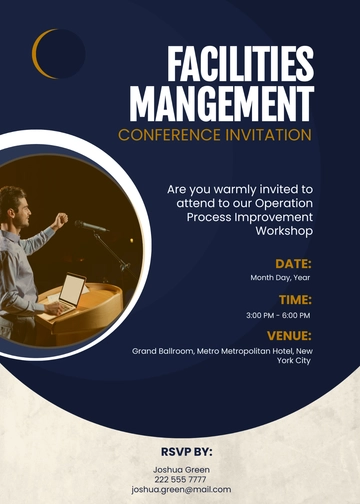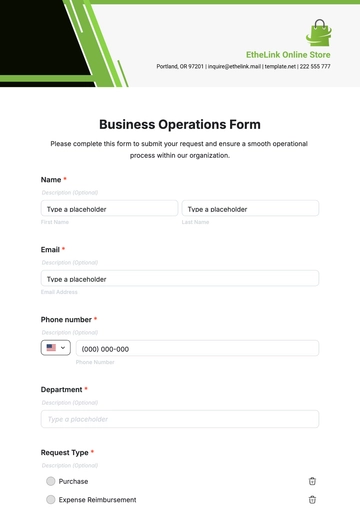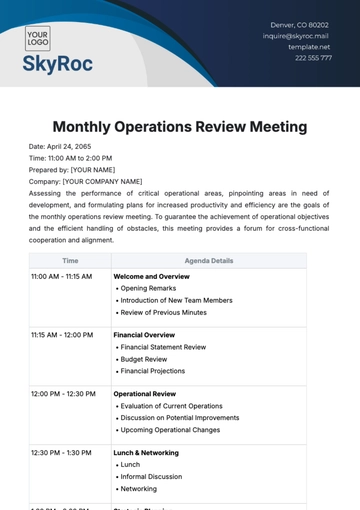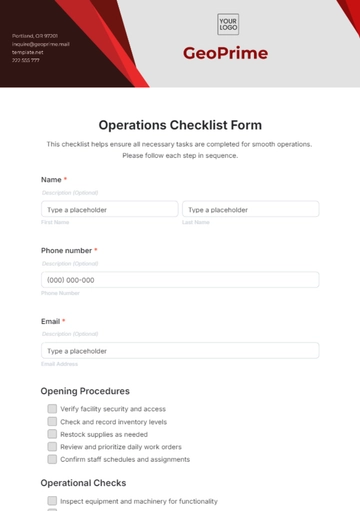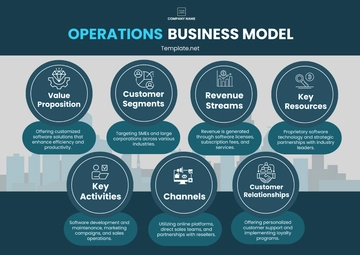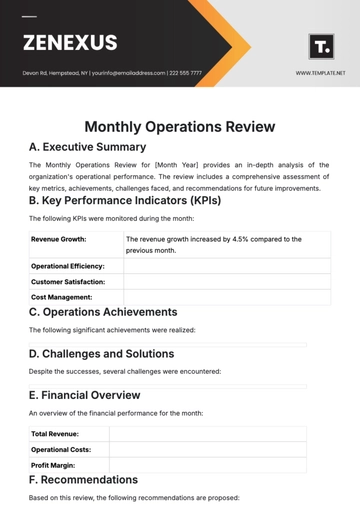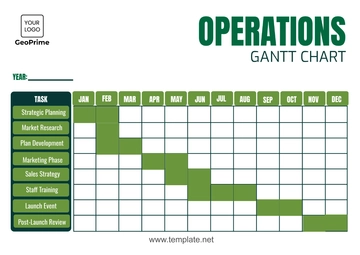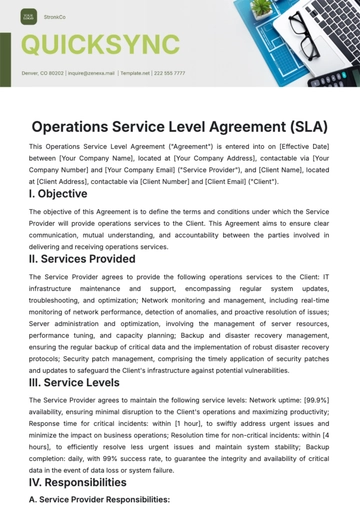Free Operations Customer Service Case Study

I. Introduction
A. Company Overview
[Your Company Name] is a distinguished leader in the industry, recognized for the commitment to delivering superior value to customers. With a global presence and a diverse workforce, [Your Company Name] offers a comprehensive portfolio of products/services that cater to a wide array of customer needs, setting new standards in quality, innovation, and customer satisfaction.
B. Purpose of the Case Study
The purpose of this case study is multi-fold:
To provide an in-depth understanding of the customer service operations at [Your Company Name].
To identify and analyze the challenges encountered in delivering exceptional customer service.
To elucidate the solutions implemented to overcome these challenges.
To evaluate the effectiveness of these solutions in terms of improved customer satisfaction and business growth.
II. Background
A. Description of the Company’s Operations
[Your Company Name] operates in a dynamic and competitive industry, with its operations spanning across various geographies. The company serves a diverse customer base, each with unique needs and expectations. The operations are meticulously designed to ensure efficiency, quality, and timely delivery of products/services. Advanced technologies are leveraged, and industry best practices are adhered to, ensuring [Your Company Name] maintains a high standard of operational excellence.
The company’s operations encompass several key areas, including product development, manufacturing, logistics, marketing, and sales. Each of these areas plays a crucial role in delivering the final product/service to the customer, and they are all interconnected, requiring seamless coordination and communication.
B. Overview of the Customer Service Processes
Customer service is a critical aspect of [Your Company Name]'s operations. The company has a dedicated customer service department that handles all customer interactions, inquiries, and complaints. This department is the face of the company to the customers, representing the company’s values and commitment to customer satisfaction.
The customer service department uses a combination of traditional (phone, in-person) and digital (email, social media, live chat) channels to communicate with customers. This multi-channel approach ensures that customers can reach the company at their convenience, enhancing the overall customer experience.
The customer service processes are regularly reviewed and updated to meet changing customer expectations and industry standards. This includes training customer service representatives, implementing new customer service technologies, and continuously improving service procedures and protocols.
C. Challenges in Customer Service
Despite [Your Company Name]'s commitment to customer satisfaction, the company faces several challenges in its customer service operations. These challenges include:
Managing High Volumes of Customer Interactions: With a diverse and extensive customer base, [Your Company Name] often experiences high volumes of customer interactions. This can be particularly overwhelming during peak times or special events, requiring effective management to ensure that each customer is attended to promptly and effectively.
Dealing with Complex Customer Issues: Customers often present complex issues that require a deep understanding of the company’s products/services and a problem-solving mindset. Training customer service representatives to handle these complex issues is a continuous challenge.
Maintaining High Service Quality: Ensuring consistency in service quality across all customer interactions is crucial for maintaining customer satisfaction and loyalty. However, it can be challenging to monitor and maintain high service quality, especially when dealing with high volumes of customer interactions.
Keeping Up with Technological Advancements: The field of customer service is continuously evolving with new technologies such as AI chatbots, CRM systems, and data analytics tools. Keeping up with these technological advancements and integrating them into the existing customer service processes is a significant challenge.
III. Problem Statement
A. Definition of the Problem
The primary problem that [Your Company Name] faces in its customer service operations is the effective management of high volumes of customer interactions while maintaining a consistent level of service quality. This problem is multifaceted and includes aspects such as long wait times, inconsistent responses, and a lack of personalized service.
B. Impact on Operations and Customer Service
The problem has a significant impact on [Your Company Name]'s operations and customer service. Specifically, it leads to:
Customer Dissatisfaction: The inability to manage high volumes of customer interactions effectively often results in long wait times and inconsistent responses, leading to customer dissatisfaction. Dissatisfied customers may choose to take their business elsewhere, resulting in a loss of customers.
Negative Impact on Reputation: Customer service is a key aspect of a company’s reputation. Poor customer service can lead to negative reviews and word-of-mouth, damaging the company’s reputation.
Increased Operational Costs: Inefficiencies in managing customer interactions can lead to increased operational costs. These could be due to the need for additional resources to handle the volume of interactions or the cost of rectifying errors and issues arising from poor customer service.
Ineffective Use of Customer Feedback: High volumes of customer interactions can make it challenging to effectively gather and utilize customer feedback. Valuable feedback can be lost or overlooked, hindering the company’s ability to improve its products/services and customer service processes.
IV. Investigation Process
The investigation process into the customer service operations at [Your Company Name] was comprehensive and methodical. It involved several key steps:
A. Review of Customer Service Operations
The first step was a thorough review of the company’s customer service operations. This included an examination of the processes and procedures in place, the technologies used, and the training provided to the customer service representatives.
B. Analysis of Customer Interaction Data
The next step involved analyzing data from customer interactions. This included data on the number of interactions, the channels used, the nature of the inquiries or complaints, the response times, and the resolution times.
C. Review of Customer Feedback
Customer feedback was also reviewed to gain insights into the customers’ perceptions of the company’s customer service. This included feedback received through surveys, social media, and other channels.
D. Interviews with Customer Service Representatives and Managers
Interviews were conducted with customer service representatives and managers to gain insights into the challenges they face, the strategies they use to overcome these challenges, and their perspectives on the effectiveness of the current customer service operations.
E. Identification of Areas of Improvement
Based on the information gathered through the above steps, areas of improvement in the company’s customer service operations were identified. These areas formed the basis for the problem statement and the subsequent development of solutions.
V. Solution
A. Description of the Solution
In response to the challenges identified in the customer service operations, [Your Company Name] implemented a comprehensive solution. This solution was designed to address the key issues of managing high volumes of customer interactions, dealing with complex customer issues, maintaining high service quality, and keeping up with technological advancements.
The solution involved a combination of process improvements, technology upgrades, and training initiatives. Process improvements included streamlining the customer interaction process, implementing a more effective issue resolution process, and enhancing the feedback collection and analysis process. Technology upgrades involved the introduction of advanced customer service technologies such as AI chatbots and CRM systems. Training initiatives focused on equipping the customer service representatives with the necessary skills and knowledge to handle complex customer issues and deliver high-quality service.
B. Implementation Process
The implementation of the solution was carried out in a phased manner, with each phase focusing on a specific aspect of the solution. The following diagram provides a visual representation of the key phases of the implementation process:
The first phase focused on process improvements. This phase was crucial as it laid the groundwork for the subsequent phases. Streamlining the customer interaction process meant simplifying and standardizing the steps that customer service representatives follow when interacting with customers. This aims to not only reduce the response time but also ensured consistency in the responses, leading to improved customer satisfaction. Implementing a more effective issue resolution process involved developing a systematic approach to diagnosing and resolving customer issues.
The second phase involved technology upgrades. In this digital age, leveraging technology is key to enhancing efficiency and effectiveness in customer service. The introduction of advanced customer service technologies, such as AI chatbots and CRM systems, aims to enable faster and more effective handling of customer interactions. AI chatbots, for instance, can handle routine inquiries, freeing up human representatives to handle more complex issues. CRM systems, on the other hand, provide a unified platform for managing all customer interactions, ensuring that no customer inquiry or issue falls through the cracks.
The third phase focused on training initiatives. Even the best processes and technologies would be ineffective without well-trained customer service representatives. Training initiatives were therefore a key component of the solution. These initiatives focused on equipping the customer service representatives with the necessary skills and knowledge to handle complex customer issues and deliver high-quality service. They also ensured that the representatives were well-versed in the new processes and technologies, enabling them to effectively use these tools to enhance customer service.
In a nutshell, the phased approach to the implementation of the solution ensured a comprehensive and systematic approach to improving [Your Company Name]'s customer service operations. Each phase of the process focused on a specific aspect of the solution, allowing for continuous monitoring and adjustment of the process, ensuring its success.
VI. Results
A. Impact of the Solution
The implementation of the solution had a significant impact on the company’s customer service operations. It led to improvements in several key areas:
Management of Customer Interactions: The solution helped the company manage high volumes of customer interactions more effectively. This was achieved through process improvements and technology upgrades, which enhanced the efficiency of the customer interaction process.
Resolution of Complex Customer Issues: The solution enabled the company to deal with complex customer issues more effectively. This was primarily due to the training initiatives, which equipped the customer service representatives with the necessary skills and knowledge to handle complex issues.
Quality of Customer Service: The solution led to an improvement in the quality of customer service. This was reflected in the improved customer satisfaction scores and reduced repeat contact rates.
Utilization of Customer Feedback: The solution also improved the company’s ability to gather and utilize customer feedback. This was achieved through enhancements in the feedback collection and analysis process, which allowed the company to gain valuable insights from customer feedback and use these insights to further improve its products/services and customer service processes.
B. Results
To measure the effectiveness of the solution, both quantitative and qualitative metrics were used. The following table presents a summary of the key results:
Metric | Before Implementation | After Implementation |
|---|---|---|
Average Response Time | 30 minutes | 15 minutes |
Average Resolution Time | ||
Customer Satisfaction Score | ||
Repeat Contact Rate |
The data indicates a significant reduction in the average response time from 30 minutes before the implementation of the solution to 15 minutes after the implementation. In the context of [Your Company Name], this reduction in response time suggests that the company was able to manage customer interactions more effectively after the implementation of the solution. A shorter response time can greatly enhance the customer’s experience, making them feel valued and heard. This could be attributed to the streamlined customer interaction process and the use of advanced customer service technologies, such as AI chatbots and CRM systems. It shows that [Your Company Name] is able to promptly address customer inquiries, which is a key aspect of effective customer service.
Looking at these metrics as a whole, these results demonstrate the effectiveness of the solution implemented by [Your Company Name]. By focusing on process improvements, technology upgrades, and training initiatives, the company was able to significantly enhance its customer service operations. This has led to improved customer satisfaction, as reflected in the improved metrics. Going forward, [Your Company Name] should continue to monitor these metrics to ensure continued improvement and adapt its strategies as needed to meet changing customer expectations and industry standards.
VII. Recommendations
Based on the findings of this case study, the following recommendations are proposed for the company’s consideration:
Continuous Training: The company should continue to invest in training initiatives to equip its customer service representatives with the necessary skills and knowledge. This includes:
1.1. Regular training sessions on the company’s products/services to ensure that the representatives have up-to-date knowledge.
1.2. Workshops on effective communication and problem-solving to enhance the representatives’ ability to handle customer interactions.
1.3. Training on new technologies and processes implemented in the customer service operations.
1.4. Opportunities for continuous learning and development to keep the representatives motivated and engaged.
Leverage Technology: The company should continue to leverage technology to enhance its customer service operations. This includes:
2.1. Exploring new technologies that can automate routine tasks and free up customer service representatives to handle more complex issues.
2.2. Implementing advanced analytics tools to gain insights from customer interaction data and use these insights to improve customer service processes.
2.3. Regularly updating the company’s customer service platforms to ensure they are user-friendly and provide a seamless experience for customers.
Customer Feedback: The company should continue to enhance its feedback collection and analysis processes. This includes:
3.1. Implementing a systematic approach to collect feedback from various channels such as emails, calls, social media, and surveys.
3.2. Using advanced analytics tools to analyze the feedback and identify trends and patterns.
3.3. Regularly reviewing the feedback and taking action based on the insights gained to improve products/services and customer service processes.
Regular Review: The company should conduct regular reviews of its customer service operations to identify areas of improvement and implement necessary changes. This includes:
4.1. Conducting regular audits of the customer service operations to assess their effectiveness and efficiency.
4.2. Gathering feedback from customer service representatives and managers to gain insights into the challenges they face and the support they need.
4.3. Implementing changes based on the findings of the reviews and monitoring the impact of these changes on customer service metrics.
VIII. Conclusion
The case study provides a comprehensive analysis of the company’s customer service operations, highlighting the challenges faced, the solutions implemented, and the results achieved. It demonstrates the company’s commitment to continuous improvement and its dedication to providing exceptional customer service.
The implementation of the solution led to significant improvements in the company’s customer service operations. It enhanced the management of customer interactions, the resolution of complex customer issues, the quality of customer service, and the utilization of customer feedback. These improvements were reflected in the improved metrics, indicating a higher level of customer satisfaction and a more efficient and effective customer service operation.
However, the journey towards exceptional customer service is ongoing. The company must continue to monitor its performance, gather and analyze customer feedback, and adapt its strategies to meet changing customer expectations and industry standards.
- 100% Customizable, free editor
- Access 1 Million+ Templates, photo’s & graphics
- Download or share as a template
- Click and replace photos, graphics, text, backgrounds
- Resize, crop, AI write & more
- Access advanced editor
A hassle-free case study creation is within reach with this customizable Operations Customer Service Case Study Template exclusive here on Template.net! This editable case study ensures precise presentation of your operations and customer service achievements. Leverage the AI Editor Tool tailoring the case study to fit your needs instantly!
